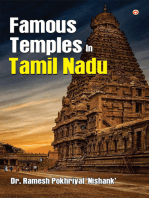Access and Axes of Indian Temples
Access and Axes of Indian Temples
Uploaded by
bongumanCopyright:
Available Formats
Access and Axes of Indian Temples
Access and Axes of Indian Temples
Uploaded by
bongumanOriginal Description:
Copyright
Available Formats
Share this document
Did you find this document useful?
Is this content inappropriate?
Copyright:
Available Formats
Access and Axes of Indian Temples
Access and Axes of Indian Temples
Uploaded by
bongumanCopyright:
Available Formats
Figure 1.
Elephanta, Maharashtra,
Shaivite cave, sanctum with
Ungarn, ca. 540 A.D.
Figure 2. Elephanta, ground plan
Figure 3. Elephanta, image of
Shiva Mahadeva
Michael W. Meister
Access and Axes of Indian Temples
At the beginning, before the creation of the world, sex, and
death, the Creator Prajapati formed Rudra-Brahma as a
pillar to separate sky and water and to start time. This
pillar, called Skambha ("the frame of creation"), instead
retreated to the bottom of the cosmic ocean, and waited for
procreation to begin by other means. "By how much did
Skambha enter the existent? How much of him lies along
intended to shelter an icon of a deity (Fig. 4). It consists
of a small masonry cube with an inner sanctum and fourpillared portico, suitable for the approach of only one
person at a time. Such a temple was a point of power,
seen as a "crossing" ( tirtha ), a mechanism for seducing
the divine into the created world, and a tool for the
transformation of the worshiper.
that which will exist?" asks the sacred Hindu text Atharva
Veda (AV X.7.9).1 First built more than a millenniumThis manifestation of the divine was gradually marked
after the Atharva Veda was compiled, an early Indian
on temple walls by axes in the ground plan that project
stone temple echoes Skambha's condensed crouchingsacred
form.
interior spaces onto offsets of the exterior walls,
providing facets where sculptures of varying aspects of the
The cubical block of the sanctum in the famed sixthdivinity and creation could be placed and viewed
century A.D. Shaiva cave on Elephanta island near
(Figs. 5 & 6). In some temples in the seventh century,
Mumbai lies compressed between the floor and ceiling however, these cardinal projections show shuttered doors
of a mountain excavation (Fig. 1). Its four cardinal
rather than images, emphasizing the secure nature of
doorways are protected by giant guardian figures. This
the shrine and limiting visual access of the deity to those
cella can be approached from two directions: on axis whose function was to administer to it in the
from an eastern court along the central aisle of a pillared
sanctum (Figs. 7 & 8).
hall, or indirectly, from the north, along an axis facing
an immense bust of the "Great Lord" Mahadeva Shiva,
Image-worship increasingly replaced rites of sacrifice
incarnate with cardinal faces (Fig. 3). This Shiva image
by the seventh and eighth centuries, and temple rituals
rests within the mountain, as if looking into the cave's
began to focus more on the role of an audience of devotees
excavation from beyond a southern entry-portico2 (Fig. 2).
and the experience of worship. The cosmological plan
of the temple expanded, but access to the shrine and
Access to early temples was at first limited to the deity
sanctum remained limited and controlled. These temples
were "monuments of manifestation"3 in Stella Kramrisch's
and its cult functionaries. Temple 17, built at Sanchi (an
early first-century Buddhist site) ca. 425 A.D., has often
words- cosmic mountains, but also markers of creation,
palaces of the gods, and machines for social order
been called the earliest surviving stone Hindu temple,
33
This content downloaded from 128.239.99.140 on Tue, 22 Nov 2016 14:32:48 UTC
All use subject to http://about.jstor.org/terms
Figure 4. Sanchi, Madhya
Pradesh, temple 17, ca. 425
Figure 5. Projection of sacred space onto walls of the temple: Bhubaneshwar, Orissa,
Parasurameshvara temple, ca. 600 (left); Mahua, MP, Shiva temple no. 1, ca. 650-75
Figure 6. Bhubaneshwar,
Parasurameshvara temple,
Figure 9. Masrur, Himachal Pradesh, Shaivite temple,
Figure 8. Sirpur, Lakshmana temple,
ca. 725-75, section
view from southwest
south view
Figure 7. Sirpur, Chattisgarh, Lakshmana
temple, wall with blind shutters, ca. 600-25
Figure 10. Masrur, ground plan
Figure 11. Expansion of temple plans: North
and South India
34
This content downloaded from 128.239.99.140 on Tue, 22 Nov 2016 14:32:48 UTC
All use subject to http://about.jstor.org/terms
Figure 12. Vishnupur, Bengal. Eastern India in the 17th century
Figure 13. Osian, Rajasthan, Sachiyamata hill, temple
complex, 8th - 20th century
(Figs. 9 & 10). Temple Hinduism gradually took on
The remarkable thing is that the once-closed machine
political and social roles that transformed the temple,
of the temple has, over time, taken on the flexibility to
expanding its plan along a path of human approach,
adapt to radically changing social circumstances, giving
an "axis of access." As architecture and changing usage
access to a variety and multitude of communities (Fig. 13).
Even as the Creator Prajapati's Skambha cowered in the
evolved over many centuries, open halls were added to
walled halls, additional pavilions were built, enclosing
primordial waters long ago, the potential for creation of
fences became compounds, and compounds grew to cities. the sexually charged, multivalent, multicultural universes
In South India, seasonal festivals and rites evolved that
served by Hindu temples had become its ordering force.6
brought the deity out into the city and countryside, giving
Early Hinduism focused on rites of sacrifice. Temples
access to populations not allowed entry to the sanctum
(Fig. 11).
to shelter images of deities were built in early medieval
India as instruments of priestly cults. To patronize cult
As I have noted elsewhere, "The Hindu temple must also
communities became a means to extend kingship. Yet
act as access and approach for aspirants and worshipers. through such community patronage, temples gradually
This role changes the temple from a centralized,
became public institutions.7 Today communities have
bilaterally symmetrical structure (reflecting the nature oftaken the place of kings, and temples function in fresh
the cosmogonie process) to one with a defined longitudinalways, with a renewal of multiple pivots of access.
axis. On that axis the worshipers approach their personal
divinity within the sanctum; but also on that axis the
aspirants increasingly can place themselves, in halls built
for that purpose, as if under the umbrella of the sacrificer, Notes
positioning themselves for ascent."4
1. Atharva-veda Samhita, trans. William Dwight Whitney, rev. and ed. Charles
Rockwell Lanman, Harvard Oriental Series, vol. 7-8 (Cambridge: Harvard
Two alignments, however, coexist. One is centralized,
University, 1905).
symmetrical, and expresses a cosmic order in which the 2. Stella Kramrisch, The Presence of S'iva (Princeton: Princeton University Press,
deity dwells. The other is linear, signifying the approach 1981), 443-68.
of humans in this world. In seventeenth-century Bengal, a3. Stella Kramrisch, The Hindu Temple (Calcutta: University of Calcutta, 1946),
new type of temple was created, built in brick, for rituals passim.
4. Michael W. Meister, "Temple: Hindu Temples," in The Encyclopedia of Religion,
"hidden" from Islamic hegemony. These temples retain
ed. Mircea Eliade (New York: Macmillan Publishing Company) vol. 14, 372: '"The
an east-west axis for priests to enter the sanctum and
whole intention of the Vedic Tradition and of the sacrifice is to define the Way by
attend to the god. But they also have a north-south axis which the aspirant ... can ascend [the three] worlds,' wrote Ananda Coomaraswamy.
'Earth, Air, and Sky ... compose the vertical Axis of the Universe.... [These are] the
to provide visual access to an assembly of devotees who
Way by which the Devas first strode up and down these worlds ... and the Way for
sing and dance in the temple's court, "emphasizing the
the Sacrificer now to do likewise.'"
participation of the community" (Fig. 12). 5 These temples 5. Pika Ghosh, Temple to Love, Architecture and Devotion in Seventeenth- Century
take on the form of a village compound. Such dual axes Bengal (Bloomington & Indianapolis: Indiana University Press, 2005), 138.
6. Michael W. Meister, "Sweetmeats or Corpses? Community, Conversion, and
for esoteric and popular rituals had already been augured Sacred Places," in Open Boundaries, Jain Communities and Cultures in Indian
at Elephanta (Fig. 3), yet here communities of worshipers History, ed. John E. Cort (Albany: State University of New York, 1998), 111-38.
7. Arjun Appadurai, "Kings, Sects and Temples in South India, 1350-1700 A.D.," in
commanded access that in previous centuries had often
been limited or denied.
South Indian Temples, ed. Burton Stein (New Delhi: Vikas Publishing House, 1978),
47-73.
35
This content downloaded from 128.239.99.140 on Tue, 22 Nov 2016 14:32:48 UTC
All use subject to http://about.jstor.org/terms
You might also like
- Environmental Sociology From Analysis To Action 2nd Edition Leslie King All Chapter Instant DownloadDocument84 pagesEnvironmental Sociology From Analysis To Action 2nd Edition Leslie King All Chapter Instant Downloadhathumusiwa100% (15)
- Open Your Mind To Prosperity by Catherine PonderDocument8 pagesOpen Your Mind To Prosperity by Catherine Ponderaashay shroff50% (2)
- Dawlance Audit ReportDocument26 pagesDawlance Audit ReportWaqas Ahmad83% (6)
- CCNA Routing and SwitchingDocument26 pagesCCNA Routing and SwitchingShaneVazNo ratings yet
- Borobudur As A YantraDocument21 pagesBorobudur As A YantraUday DokrasNo ratings yet
- Ambika Mata TempleDocument6 pagesAmbika Mata TempleAnmol YaduvanshiNo ratings yet
- Thesis KhajurahoDocument42 pagesThesis KhajurahoshreyaNo ratings yet
- Indian Architecture: Presented By: Kim Molina Maisie RiveraDocument125 pagesIndian Architecture: Presented By: Kim Molina Maisie RiveraAndrew AmedaNo ratings yet
- Rupa Arupa and Rupa Arupa The Three FormDocument37 pagesRupa Arupa and Rupa Arupa The Three FormUday DokrasNo ratings yet
- Lec 3Document23 pagesLec 3Dhiksha KishoreNo ratings yet
- 2006 9 TempleDocument6 pages2006 9 TempleDaniel ManziniNo ratings yet
- The Temple As A MandalaDocument11 pagesThe Temple As A MandalaUday DokrasNo ratings yet
- Hindu TempleDocument6 pagesHindu TempleGrapes als Priya100% (1)
- Art of Mauurya Period: Pillars, Sculptures and Rock-Cut ArchitectureDocument3 pagesArt of Mauurya Period: Pillars, Sculptures and Rock-Cut ArchitecturemirzaNo ratings yet
- The Great StupaDocument17 pagesThe Great StupanikitaNo ratings yet
- Chapter - Iv Temple ArchitectureDocument32 pagesChapter - Iv Temple ArchitectureAdam MusavvirNo ratings yet
- Angkor As YantraDocument35 pagesAngkor As YantraUday DokrasNo ratings yet
- Comparison of The Design of Prasat Auk Um and The 11 TH Century Baphuon With Masrur Temple IndiaDocument11 pagesComparison of The Design of Prasat Auk Um and The 11 TH Century Baphuon With Masrur Temple IndiaUday DokrasNo ratings yet
- A Case Study of Hayagriva Madhava Temple SculpturesDocument40 pagesA Case Study of Hayagriva Madhava Temple SculpturesSandeep KumarNo ratings yet
- Yoni BookDocument189 pagesYoni BookUday DokrasNo ratings yet
- Section-A: 1. Development of Sanchi StupaDocument6 pagesSection-A: 1. Development of Sanchi StupaShivam SinghNo ratings yet
- Chapter 6 - The Early Stupa - Sanchi, Bharhut, Amaravati and NagarjunakondaDocument23 pagesChapter 6 - The Early Stupa - Sanchi, Bharhut, Amaravati and NagarjunakondaAbhilash Chetia100% (1)
- Temple Architecture, C. 300 - 750 CE: Cultural DevelopmentDocument25 pagesTemple Architecture, C. 300 - 750 CE: Cultural DevelopmentShreosi BiswasNo ratings yet
- Report On Prambanan History of Eastern Art & Architecture (INA263)Document12 pagesReport On Prambanan History of Eastern Art & Architecture (INA263)Tia AhmadNo ratings yet
- Buddhist Religious Architecture Developed inDocument11 pagesBuddhist Religious Architecture Developed inSonal SharmaNo ratings yet
- ch3 PDFDocument8 pagesch3 PDFjayant5253No ratings yet
- 12 Chapter 5Document31 pages12 Chapter 5Tanya LokwaniNo ratings yet
- Swayambhu NathDocument6 pagesSwayambhu NathJen PokharelNo ratings yet
- Shiva and Parvati EssayDocument4 pagesShiva and Parvati EssayAditya KarandikarNo ratings yet
- B1.Evolution of TemplesDocument12 pagesB1.Evolution of TemplesAbhay SharmaNo ratings yet
- 7 Century Hawan Kund Fire Altar of 13 Hast 16638 CDocument9 pages7 Century Hawan Kund Fire Altar of 13 Hast 16638 Chistoricaljourney001No ratings yet
- Hindu Temple Fractals - Vastu N Carl JungDocument31 pagesHindu Temple Fractals - Vastu N Carl JungDisha TNo ratings yet
- Arts of The Mauryan Period Indian Culture Series NCERTDocument6 pagesArts of The Mauryan Period Indian Culture Series NCERTDHUVADU JAGANATHAMNo ratings yet
- Temple SculptureDocument13 pagesTemple Sculpturenamanm007No ratings yet
- Temple ArchitectureDocument19 pagesTemple ArchitectureABHISHNo ratings yet
- Notes For XIDocument34 pagesNotes For XIArpit YadavNo ratings yet
- Temple Gopuram As Cosmos & Spiritual Light HouseDocument28 pagesTemple Gopuram As Cosmos & Spiritual Light HouseUday DokrasNo ratings yet
- Vedic Architecture: V .Surya TejaDocument26 pagesVedic Architecture: V .Surya Tejaarchitectfemil6663No ratings yet
- Gandhara EffectDocument28 pagesGandhara EffectUday DokrasNo ratings yet
- 13 Chapter 4Document42 pages13 Chapter 4indrani royNo ratings yet
- Sun-Temple at Modhera (Gujarat) : by Dr. Advaitavadini KaulDocument3 pagesSun-Temple at Modhera (Gujarat) : by Dr. Advaitavadini KaulGandhi SagarNo ratings yet
- SunTemple Modhera GujaratDocument3 pagesSunTemple Modhera GujaratGandhi SagarNo ratings yet
- Donaldson-Erotic Rituals On Orissan TemplesDocument47 pagesDonaldson-Erotic Rituals On Orissan TemplesatziNo ratings yet
- Arts of The Mauryan PeriodDocument6 pagesArts of The Mauryan PeriodNimisha SwarupNo ratings yet
- Stupa ArchitectureDocument8 pagesStupa Architectureramish mushfiqNo ratings yet
- Angkor Landcape As Mount MeruDocument127 pagesAngkor Landcape As Mount MeruUday DokrasNo ratings yet
- Curvilinear Roof Temples of INDIADocument15 pagesCurvilinear Roof Temples of INDIAudayNo ratings yet
- Kefa 106Document35 pagesKefa 106Anushka GargNo ratings yet
- Designing A TempleDocument138 pagesDesigning A Templebaabjitvk100% (2)
- Temple Architecture 1Document11 pagesTemple Architecture 1kengerisudhirNo ratings yet
- The Complete Book On Hindu MANDIR TempleDocument114 pagesThe Complete Book On Hindu MANDIR TemplesaishaahresthNo ratings yet
- Minakshi Temple ReportDocument17 pagesMinakshi Temple Reportanuska.tuladharNo ratings yet
- StupaDocument23 pagesStupaNahar LizaNo ratings yet
- Yoni VulvaDocument15 pagesYoni VulvaUday DokrasNo ratings yet
- History of Temples of Historical Places OdishaDocument15 pagesHistory of Temples of Historical Places OdishaRiyaz KhanNo ratings yet
- Shaiv and Shakta Schools of SpiritualityDocument22 pagesShaiv and Shakta Schools of SpiritualityUday DokrasNo ratings yet
- Degah, The Triple Chariot of God-Symbolism in ArchitectureDocument8 pagesDegah, The Triple Chariot of God-Symbolism in ArchitectureBina AdhikariNo ratings yet
- AshtadikpalakasDocument3 pagesAshtadikpalakasBalaji SrinivasanNo ratings yet
- Orissa Review-Saktism at BhubaneswarDocument5 pagesOrissa Review-Saktism at BhubaneswarpervincarumNo ratings yet
- SriyantraDocument42 pagesSriyantraUday DokrasNo ratings yet
- Famous Temples in Tamil NaduFrom EverandFamous Temples in Tamil NaduRating: 5 out of 5 stars5/5 (1)
- KENDALL Cognitive-Behavioral Therapies With YouthDocument13 pagesKENDALL Cognitive-Behavioral Therapies With YouthbongumanNo ratings yet
- Donald J Twitter FeedDocument8 pagesDonald J Twitter FeedbongumanNo ratings yet
- The Weaving of Original Textiles Influenced by Pre-Columbian Peru PDFDocument70 pagesThe Weaving of Original Textiles Influenced by Pre-Columbian Peru PDFbongumanNo ratings yet
- Tapestry PDFDocument6 pagesTapestry PDFbongumanNo ratings yet
- Chapter #7 Giancoli 6th Edition Problem SolutionsDocument8 pagesChapter #7 Giancoli 6th Edition Problem SolutionsbongumanNo ratings yet
- Gvantseladze - Ena - Da - KiloDocument81 pagesGvantseladze - Ena - Da - Kilogvantseladze100% (1)
- Effect of Conflict Management On Organizational PerformanceDocument14 pagesEffect of Conflict Management On Organizational PerformanceMr SananNo ratings yet
- Assignment 07Document6 pagesAssignment 07Justin KalseNo ratings yet
- Caja Leach Diagrama de PartesDocument137 pagesCaja Leach Diagrama de PartesAndres CruzNo ratings yet
- Algebraic and Symbolic ReasoningDocument36 pagesAlgebraic and Symbolic ReasoningEnric DescalsotaNo ratings yet
- The Self - Consumer BehaviorDocument37 pagesThe Self - Consumer BehaviorFunda YildirimNo ratings yet
- SQL To Pyspark ConversionDocument9 pagesSQL To Pyspark Conversionyikogoy117No ratings yet
- Herméneutique de La MusiqueDocument15 pagesHerméneutique de La MusiqueOlga SofiaNo ratings yet
- Đề Kiểm Tra Theo Từng Unit Unit 7: PollutionDocument12 pagesĐề Kiểm Tra Theo Từng Unit Unit 7: PollutionbuitinhNo ratings yet
- Reduced Risk of AnxietyDocument7 pagesReduced Risk of AnxietySyaika Amelia ZahraNo ratings yet
- NMDC Private LTD. Kirandul (C.G)Document15 pagesNMDC Private LTD. Kirandul (C.G)Rohini YadavNo ratings yet
- Unit 5: Valuation of Fixed AssetsDocument24 pagesUnit 5: Valuation of Fixed AssetsRahul GuptaNo ratings yet
- DB Iqc Template OdfDocument159 pagesDB Iqc Template OdfDương Phan HảiNo ratings yet
- Text Operation AssingnmetDocument33 pagesText Operation Assingnmetbeshahashenafe20No ratings yet
- Brain Drain From PakistanDocument17 pagesBrain Drain From PakistanHira Noor67% (3)
- The Hacker, Hacking Tactics and The VictimDocument38 pagesThe Hacker, Hacking Tactics and The VictimSarah Jane DiazNo ratings yet
- Teaching Guide To AssessmentDocument38 pagesTeaching Guide To Assessmentmv2fyq6tg2No ratings yet
- 23 Condensers & EvaporatorsDocument26 pages23 Condensers & EvaporatorsPRASAD326100% (5)
- 417E 6 2007 U.S. Navy Testing Questions DARPA Sonic Projectors Just An Item of Interest For Further Research June 5 2007Document7 pages417E 6 2007 U.S. Navy Testing Questions DARPA Sonic Projectors Just An Item of Interest For Further Research June 5 2007Lazlo SecretNo ratings yet
- Schedule D: List of Life Saveing or Life Sustaining Medical DevicesDocument5 pagesSchedule D: List of Life Saveing or Life Sustaining Medical DevicesAasma RehmanNo ratings yet
- Unit 4Document24 pagesUnit 4Sankalp MishraNo ratings yet
- Profile-SamSad InteriorDocument16 pagesProfile-SamSad InteriorMd Farid AhmedNo ratings yet
- IRWA AmmoniaChlorine2018Document127 pagesIRWA AmmoniaChlorine2018testNo ratings yet
- Financial Statement Modeling Course Manual - 647883d6d91e8Document121 pagesFinancial Statement Modeling Course Manual - 647883d6d91e8brandkNo ratings yet
- Cutting Force Measurement: New Rotating Dynamometer For The Analysis of High Speed Cutting ProcessesDocument15 pagesCutting Force Measurement: New Rotating Dynamometer For The Analysis of High Speed Cutting ProcessesAmR El SHeNaWyNo ratings yet
- Perceptions of Public RelationsDocument55 pagesPerceptions of Public RelationsBazil MucunguziNo ratings yet






























































































